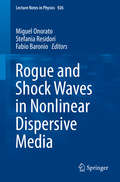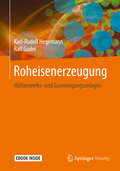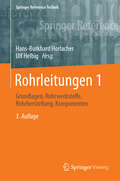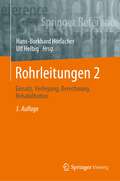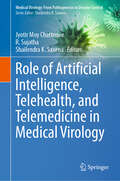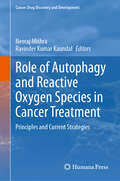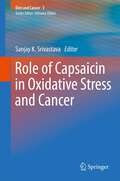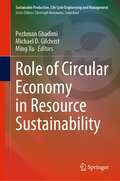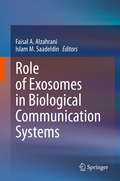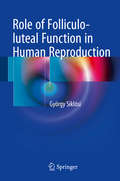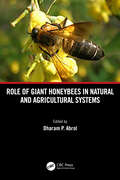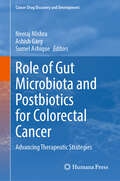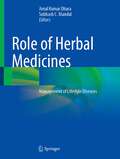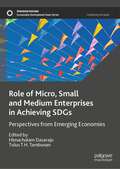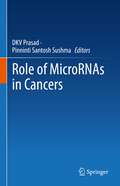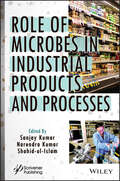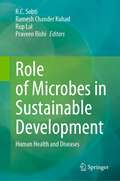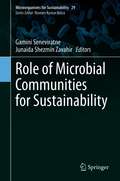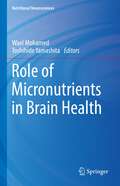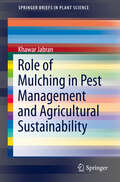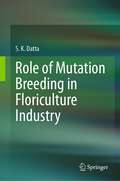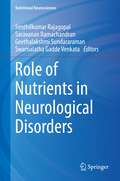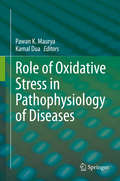- Table View
- List View
Rogue and Shock Waves in Nonlinear Dispersive Media
by Miguel Onorato Stefania Resitori Fabio BaronioThis self-contained set of lectures addresses a gap in the literature by providing a systematic link between the theoretical foundations of the subject matter and cutting-edge applications in both geophysical fluid dynamics and nonlinear optics. Rogue and shock waves are phenomena that may occur in the propagation of waves in any nonlinear dispersive medium. Accordingly, they have been observed in disparate settings - as ocean waves, in nonlinear optics, in Bose-Einstein condensates, and in plasmas. Rogue and dispersive shock waves are both characterized by the development of extremes: for the former, the wave amplitude becomes unusually large, while for the latter, gradients reach extreme values. Both aspects strongly influence the statistical properties of the wave propagation and are thus considered together here in terms of their underlying theoretical treatment. This book offers a self-contained graduate-level text intended as both an introduction and reference guide for a new generation of scientists working on rogue and shock wave phenomena across a broad range of fields in applied physics and geophysics.
Roheisenerzeugung: Hüttenwerks- und Gasreinigungsanlagen
by Karl-Rudolf Hegemann Ralf GuderDieses Buch beschreibt die metallurgischen Vorgänge, Thermodynamik, Strömungsmechanik und Verfahrenstechnik der Roheisenerzeugung im Hinblick auf die Hüttenwerks- und Gasreinigungsanlagen. Zahlreiche Abbildungen veranschaulichen den die Beschreibungen.
Rohrleitungen 1: Grundlagen, Rohrwerkstoffe, Rohrherstellung, Komponenten
by Hans-Burkhard Horlacher Ulf HelbigAls Springer Reference bietet die nunmehr 3. Auflage des Fachbuchs Rohrleitungen 1 und 2 eine anspruchsvolle, wissenschaftlich fundierte Fakten- und Wissenssammlung, die sich auf den kompletten Bereich der Rohrleitungstechnologie erstreckt. Das Buch stellt eine unentbehrliche Hilfe zum konstruktiven Verständnis, zur Funktionsweise und zum Betrieb von Rohrleitungen aller Art dar. Band 1 versteht sich als Basis zum Band Rohrleitung 2 und dessen Schwerpunkten zu Einsatzfeldern von Rohrleitungen, deren Bemessung und Berechnung, zu Verlegung und Einbau sowie zur Rehabilitation oder Sanierung von Altleitungen. Der Teil Rohrleitung 1 richtet den Fokus auf die Grundlagen, Rohrwerkstoffe, Rohrherstellung und auf wichtige Rohrleitungskomponenten wie Armaturen, Messeinrichtungen oder Kompensatoren. Zahlreiche Abbildungen und Diagramme, Tabellen sowie Beispiele runden die Ausführungen ab.
Rohrleitungen 2: Einsatz, Verlegung, Berechnung, Rehabilitation
by Hans-Burkhard Horlacher Ulf HelbigAls Springer Reference bietet die nunmehr 3. Auflage des Fachbuchs Rohrleitungen 1 und 2 eine anspruchsvolle, wissenschaftlich fundierte Fakten- und Wissenssammlung, die sich auf den kompletten Bereich der Rohrleitungstechnologie erstreckt. Das Buch stellt eine unentbehrliche Hilfe zum konstruktiven Verständnis, zur Funktionsweise und zum Betrieb von Rohrleitungen aller Art dar. Band 2 versteht sich als Erweiterung zum Band Rohrleitung 1 und dessen Schwerpunkten zu den unterschiedlichen Rohrwerkstoffen, der Rohrherstellung oder den betriebswichtigen Rohrleitungskomponenten. Der Teil Rohrleitung 2 richtet den Fokus auf die verschiedenen praktischen Einsatzfelder von Rohrleitungen, deren Bemessung und Berechnung, die Verlegung und den Einbau sowie die Rehabilitation bzw. Sanierung von Altleitungen. Zahlreiche Abbildungen und Diagramme, Tabellen sowie Beispiele runden die Ausführungen ab.
Rohrleitungen 2: Einsatz, Verlegung, Berechnung, Rehabilitation (Springer Reference Technik)
by Hans-Burkhard Horlacher Ulf HelbigAls Springer Reference bietet die Neuauflage des Fachbuchs eine anspruchsvolle, wissenschaftlich fundierte Fakten- und Wissenssammlung, die sich auf den kompletten Bereich der Rohrleitungstechnologie erstreckt. Im zweiten Band werden die anwendungsorientierten Themen vertieft. Der praktische Nutzen berücksichtigt sowohl planerische Erfahrungen als auch Erfahrungenmit Betriebsszenarien, die zur Instandhaltung und Erneuerung bestehender Systeme herangezogen werden können. Das Buch stellt eine unentbehrliche Hilfe zum konstruktiven Verständnis, zur Funktionsweise und zum Betrieb von Rohrleitungen aller Art dar. Als Erweiterung zu Band 1 und dessen Ausführungen zu verschiedenen Werkstoffen, Rohrkonstruktionen, Rohrleitungskomponenten und Zubehör erläutert der Band 2 schwerpunktmäßig neben den Einsatzfeldern und dem Einbau von Rohrleitungen auch deren Berechnung und Auslegung sowie die Instandhaltung und Rehabilitation. Zahlreiche Abbildungen und Diagramme, Tabellen sowie Beispiele runden die theoretischen Ausführungen ab.
Rohrleitungs- und Apparatebau
by Günter ScholzVon einem erfahrenen Praktiker geschrieben, liefert der Band sowohl das theoretische als auch das praktische Wissen für die Planung und Ausführung von Rohrleitungen und Versorgungsrohrnetzen für Hochdruckdampf, Heißwasser, Druckluft und Kühlwasser. Der Autor leitet die strömungstechnischen und konstruktiven Grundlagen sowie alle für den Rohrleitungs- und den Apparatebau erforderlichen Berechnungsverfahren her und demonstriert ihre Anwendung in vollständig durchgerechneten Beispielen. Das Buch enthält Tabellen mit Stoffwerten sowie Arbeitsdiagramme.
Role of Artificial Intelligence, Telehealth, and Telemedicine in Medical Virology (Medical Virology: From Pathogenesis to Disease Control)
by R. Sujatha Jyotir Moy Chatterjee Shailendra K. SaxenaThe book explores the intersection of AI, telehealth, and viral infections, discussing the role of AI in pandemics, telehealth services, viral diagnosis, and antiviral drug development. It explores the integration of AI into telehealth, predicting outbreaks and monitoring mutations. The book emphasizes patient-centric healthcare, highlighting AI's transformative potential in infectious diseases. It covers medical virology, bioinformatics, machine learning, and neural networks. AI enables streamlined workflows, improved patient care, and new research methodologies. It addresses challenges and tailored solutions for AI integration in telehealth. It serves as a valuable resource for clinicians, physicians, virologists, researchers, and healthcare professionals seeking to navigate the evolving landscape of telehealth and harness the full potential of AI in transforming healthcare delivery.
Role of Autophagy and Reactive Oxygen Species in Cancer Treatment: Principles and Current Strategies (Cancer Drug Discovery and Development)
by Neeraj Mishra Ravinder Kumar KaundalAutophagy is a catabolic process that eliminates damaged and faulty cellular components via lysosomes. It responds to adverse circumstances like nutritional deficiency, hypoxia, and oxidative damage. Reactive oxygen species (ROS) cause oxidative stress, which is a multidimensional chemical that drives various pathophysiological diseases, including cancer. In addition, the autophagy process has a double role, first preventing tumour formation, but later fostering tumour progression. A growing body of research suggests that autophagy and ROS have a complex interplay in which they can either prevent cancer growth or enhance disease genesis. While a combination of autophagy inhibitor and cytotoxic medicines is now being used in cancer treatment, investigating the potential of autophagy inhibitors for overcoming resistance to different anticancer medications and how this relates to the control of cancer micro environmental stressors raises several questions. Autophagy's dual functions as a safeguarding and cytotoxic process have drawn attention to its significance in the development of cancer.
Role of Capsaicin in Oxidative Stress and Cancer
by Sanjay K. SrivastavaThis book describes the mechanism of the anti-cancer effects of capsaicin including the involvement of cytochrome P-450 in the bioactivation; identification of mitochondria as the key target site for oxidative stress; involvement of mitochondrial respiratory chain in the production of ROS; prevention of chemically-induced carcinogenesis, discussion on TRPV-1 receptor mediated or independent anti-cancer effects; identification of p53 activation as a possible mechanism; involvement of Cox-2 in apoptosis, suppression of transcription factors such as NF-kB and STAT-3; inhibition of cell survival pathways including PI3K/Akt and the involvement of intrinsic mitochondrial cell death pathway.
Role of Circular Economy in Resource Sustainability (Sustainable Production, Life Cycle Engineering and Management)
by Ming Xu Pezhman Ghadimi Michael D. GilchristThis book aims to provide academic and industrial applications advancing the critical role of circular economy principles in the sustainability of various resources. The latest research and practice in resource sustainability are shared, discussed, and promoted. The core competency of this book revolves around providing recent advances in sustainable consumption and production implementations, developed tools for environmental and sustainability assessment, technological advancements in resource and waste management/treatment, and advances in waste reduction, reuse, recycling, and recovery. Resources are defined broadly to include (1) physical resources: metals, non-metallic minerals, energy, and water (2) biological resources: food, forestry, land, ecological systems, etc., and (3) “misplaced” resources: air emissions, water pollutants, and solid waste. Finally, legislation, and policy implications and recommendations for resources sustainability are concluded.
Role of Exosomes in Biological Communication Systems
by Faisal A. Alzahrani Islam M. SaadeldinThis book reviews the role of exosomes and extracellular vesicles in both normal and pathological conditions. It first explains isolation methods for exosomes, and analyzes their fine structure and biological functions. Further, it highlights exosomes’ role as the key regulator in embryonic-maternal communication, and in the pathogenesis of various diseases, including cancer and urogenital, infectious, and neurodegenerative diseases. Moreover, it reviews the latest advances in using stem-cell-derived exosomes as a cell-free strategy in regenerative medicine, as well as the potential of exosomal microRNA as a promising non-invasive biomarker and targetable factor in cancer diagnosis and treatment. Lastly, it explores the use of natural and synthetic exosomes as nano-vehicles for efficient drug delivery.
Role of Folliculo-luteal Function in Human Reproduction
by György SiklósiThis book is the first to explain fully the crucial role of folliculo-luteal function in recurrent miscarriage, unexplained infertility, preterm birth, intrauterine growth retardation, preeclampsia, random chromosomal abnormalities, and age-related reproductive disorders. In addition it describes treatments to avoid these conditions and proposes a novel method, "hormonal wedge resection", that can successfully cure infertility associated with polycystic ovary syndrome. Importantly, the conclusions drawn in this book are based on the therapeutic results observed in a representative patient population. The method developed by the author to quantitatively diagnose the hormonal insufficiency of ovulatory cycles (folliculo-luteal insufficiency, FLI) has made it possible to recognize the formerly unclear importance of this function in human reproduction. Folliculo-luteal function determines the conditions of placentation and thus the features of the developed placenta and the outcome of pregnancy. Different grades of FLI are associated with consequences of varying severity that can be prevented by normalization of folliculo-luteal function prior to conception. This book will be required reading for all obstetricians and gynecologists.
Role of Giant Honeybees in Natural and Agricultural Systems
by Dharam P. AbrolRole of Giant Honeybees in Natural and Agricultural Systems provides multidisciplinary perspective about the different facets of giant honeybees. Giant honeybees–Apis dorsata and Apis laboriosa are excellent pollinators of crops, fruits, and vegetables in cultivated and natural lanscapes. Their large size, long foraging range, and large work force make them the most spectacular of all honeybee species for crop pollination and honey production. Due to their decline, ecosystems and global food security are being threatened. This book is the first of its kind which deals in detail on varied aspects of giant honeybee biology, management, conservation strategies for protecting biodiversity and enhancing crop productivity. It aims to promote a large, diverse, sustainable, and dependable bee pollinator workforce that can meet the challenge for optimizing food production in 21st century. SALIENT FEATURES: Covers the latest information on various aspects of biology of giant honeybees and brings the latest advances together in a single volume for researchers and advanced level students Provides an excellent source of advanced study material for academics, researchers and students and programme planners Provides an excellent source of livelihood in mountainous areas and marginal farmers Deals with biology, management and conservation strategies for protecting biodiversity and enhancing crop productivity. Excellent pollinator of tropical and subtropical crops, fruits, vegetables, etc. less prone to diseases and enemies This book will be useful for pollination biologists, honeybee biologists, scientists working in agriculture, animal behavior, conservation, biology, ecology, entomologists, environmental biologists, etc.
Role of Gut Microbiota and Postbiotics for Colorectal Cancer: Advancing Therapeutic Strategies (Cancer Drug Discovery and Development)
by Neeraj Mishra Sumel Ashique Ashish GargThe emerging role of gut microbiota and postbiotics has implications for the management of not only human health and diseases, but also colorectal cancer in particular, as these elements influence colorectal cancer pathogenesis, treatment, and prevention. This book bridges the gap between cutting-edge research and practical clinical applications in the management of colorectal cancer by offering a fresh perspective on potential therapeutic strategies and exploring the significance of microbiota in the oncology landscape. Chapters delve into the specific impacts of postbiotics, linking them to immune response modulation, inflammation reduction, and direct anticancer effects. Chapters also explore current and emerging therapies, including the manipulation of gut microbiota and the use of postbiotics supplements. Clinical trial results, case studies, and expert opinions are interwoven to present a realistic view of the benefits, limitations, and future prospects of these innovative therapeutic strategies. This book is rounded out with perspectives on future research directions in this area, discussing potential next-generation therapies such as personalized medicine approaches and biotechnological advancements, and further contemplating broader implications of microbiota research on public health strategies. Informative and engaging, this book provides clinicians and researchers alike with a deeper understanding of how postbiotics can be harnessed in colorectal cancer treatment and potentially, the treatment of other cancers influenced by gut health.
Role of Herbal Medicines: Management of Lifestyle Diseases
by Subhash C. Mandal Amal Kumar DharaEmergence of lifestyle diseases, e.g., type II diabetes, cancers, obesity, cardiovascular disorders, liver cirrhosis, etc., are exponentially increasing day by day. Modern drifts toward the utilization of herbal medicines in different healthcare aspects necessitate (demand) the replacement of synthetic molecules with phytoconstituents because of their biocompatibility, biodegradability, economic extraction process, and ready availability from the natural source. This book provides a thorough insight into the comprehensive and up-to-date trends of phytomedicines in the management of lifestyle diseases and its mechanisms, modern methods of extraction and purification of phytoconstituents, and chemical characterization as well as standardization of phytoconstituents using modern equipments.
Role of Micro, Small and Medium Enterprises in Achieving SDGs: Perspectives from Emerging Economies (Sustainable Development Goals Series)
by Tulus T.H. Tambunan Himachalam DasarajuThis book discusses and provides empirical evidence of the importance of Micro, Small and Medium Enterprises (MSMEs) in achieving Sustainable Development Goals (SDGs) in a number of developing countries. In doing so, the book focuses on the contributions of MSMEs to national efforts, directly or indirectly, to achieve poverty reduction (Goal 1), zero hunger (Goal 2), good health and wellbeing (Goal 3), quality education (Goal 4), gender equality (Goal 5), clean water & sanitation (Goal 6), income distribution (Goal 10), and sustainable cities & communities (Goal 11). The book consists of chapters discussing evidence on these particular topics based on research from various countries including Indonesia, India, Sri Lanka, Nepal and Malaysia.
Role of MicroRNAs in Cancers
by Dkv Prasad Pinninti Santosh SushmaThis book discusses the potential roles of miRNA as a crucial regulator in cancer biology. It examines the regulation of drug resistance by miRNAs in cancers and the mechanism of their deregulated expression. The book discusses the role and molecular mechanism of miRNA in regulating cellular proliferation and cell cycle. It analyses circulating miRNAs as biomarkers for cancer diagnosis and prognosis. It also analyzes the role of miRNA as a modulator of the development and function of tumor-associated immune cells. It explores the cross-talk between miRNA and reactive oxygen species (ROS) in pathogenesis, cancer therapeutic tolerance, and resistance. It provides insights into the role of miRNA in cancer angiogenesis, metastasis and describes strategies and associated challenges of miRNA-based therapies.
Role of Microbes in Industrial Products and Processes
by Sanjay Kumar Narendra Kumar Shahid-Ul-IslamROLE OF MICROBES IN INDUSTRIAL PRODUCTS AND PROCESSES The book covers recent breakthroughs and highlights the major role microbes play in industrial products and processes. With the advent of industrial biotechnology, microbes became popular as cell factories, and with the recent advancements in recombinant DNA technology, the application of microorganisms in various sectors has increased enormously for the development of various processes and products. Role of Microbes in Industrial Products and Processes covers recent breakthroughs and highlights the major role microbes play in industrial products and processes. It mainly focuses on the bio-refinery concept where bio-energy production and wastewater treatment are done simultaneously using micro-algae. Additionally, this book describes the role of microbes involved in the production of various enzymes, organic acids, and bio-polymers. It also provides detailed insight on modeling and simulation of bioprocess for the production of sugar alcohol; recovery of value-added products from organic waste using microbes is also reported. Detailed insights into the treatment of wastewater released from various industries, especially pharmaceutical wastewater, are given. Audience The book is intended for researchers, scientists, and postgraduates in chemical/biochemical engineering and bioprocess engineering, and others working in the domain of food microbiology, bioenergy/refinery, waste valorization to value-added products, and microbial production of bioplastics, sugar alcohols, enzymes, and organic acids.
Role of Microbes in Sustainable Development: Human Health and Diseases
by Ramesh Chander Kuhad R. C. Sobti Rup Lal Praveen RishiThis book examines the role of human microbiome in human health and diseases. The initial chapters present tools for genetic manipulation of gut microbiota and the therapeutic applications of engineered microbiota. They discuss the interaction between human microbiota and host in defining the prominent role of microbes in the development and progression of major human diseases. The book also summarizes the current applications and trends for the development, production and analytical characterization of recombinant therapeutic proteins in microbial systems. It also reviews the role of microbes in the production of vaccines and antibiotics. Further, the book presents bacterial products, including proteins, enzymes, immunotoxins and secondary metabolites, that target cancer cells and cause tumour regression. The chapters also discuss the critical role of gut microbiota dysbiosis in the pathogenesis of autoimmune disease and in bowel-related diseases. Towards the end, the book explores the role of intestinal microbiota in metabolic health and the pathogenesis of common metabolic disorders. It presents state-of-the-art insights into important aspects of United Nations—Sustainable Developmental Goal 3.
Role of Microbial Communities for Sustainability (Microorganisms for Sustainability #29)
by Gamini Seneviratne Junaida Shezmin ZavahirThis book is about the role played by microbes in their community mode in sustaining ecosystems. The descriptions given in its chapters indicate clearly that microbial communities are more effective in delivering multifaceted benefits to the soil-plant system than those offered by microbial monocultures in planktonic modes. The role these communities play in a multitude of microbe-microbe and plant-microbe interactions have not yet been fully exploited to gain benefits in this field as well as to achieve sustainability in agriculture practices. Amply discussed are the beneficial characteristics and metabolic capacities of specific microbial groups and the use of microbial traits for the benefit of plant growth. The book suggests the need to develop new microbial technologies to utilize plant-associated microbes for increased crop productivity and agroecosystem balance in order to ensure sustainability. This also provides an effective guidance to scientists, academics, researchers, students and policy makers of the sphere to achieve the above outcomes.
Role of Micronutrients in Brain Health (Nutritional Neurosciences)
by Wael Mohamed Toshihide YamashitaThis book comprehensively reviews the relationship between micronutrients and brain in health and diseases. It explains the relationship between micronutrients and brain functions, neurogenesis, and cognitive functions. The book also explores the relationship between micronutrients and brain disorders including depression, epilepsy, PD, and Autism. It further explores the recent advancements in understanding the important role of micronutrients as therapeutics in various brain disorders like TBI and AD. Lastly, it presents an overview of micronutrients as neuroprotective agents along with the main principles of nutrigenomics.
Role of Mulching in Pest Management and Agricultural Sustainability (SpringerBriefs in Plant Science)
by Khawar JabranThis book provides the concepts, techniques, and recent developments with regard to use of mulches in agriculture, utility of mulches for non-chemical pest control, and sustainability of crop production systems. Non-conventional means of improving the sustainability of crop production and pest control are required in the wake of environmental concerns over the use of conventional pesticides as well as the intensive use of land resources. Mulches have been used in agriculture for various purposes; however, there has been an increase in their use more recently, and scientists around the world have conducted more research to explore the benefits of mulching in various agricultural systems. Mulches have been found advantageous in non-chemical pest control, soil and water conservation, improving fertility, and improving microbial activities in the soil. While this is a topic of current importance, the information use of mulches in agricultural fields is rarely compiled in one comprehensive location to provide a full account of various aspects of mulches and their utility. This book will be helpful for researchers, growers, and students.
Role of Mutation Breeding In Floriculture Industry
by S.K DattaThis monograph provides a comprehensive review of many aspects of current interest and progress on mutation research on vegetatively propagated ornamentals. It covers almost all aspects of induced mutagenesis on ornamental plants. Chapters in this title provides information about mutation technology for the development of new ornamental varieties. Taking all aspects together, it is an excellent reference book of updated information on mutation breeding on vegetatively propagated ornamentals. Floriculture has become a very important industry in many countries as a result of science-based techniques and a steady supply of improved plant materials. The induced mutation is now recognized as well as a standardized valuable tool for the development of new varieties. The book provides an authoritative review account of all important aspects related to inducing mutagenesis in the field of ornamental crops. The primary objective of the book is to give a coherent and concise account of earlier work with an emphasis on recent developments. The knowledge generated so far has been reviewed in this book which can work as a knowledge base to prepare guidelines for future planning of successful application of mutation technology for the floriculture industry. The information in the book is an excellent informative document for researchers, teachers, students, and breeders for understanding the application of induced mutations and planning future strategies for the development of new ornamental varieties for the floriculture industry.
Role of Nutrients in Neurological Disorders (Nutritional Neurosciences)
by Senthilkumar Rajagopal Saravanan Ramachandran Geethalakshmi Sundararaman Swarnalatha Gadde VenkataThis book provides the latest research on the role of nutrients in the prevention and treatment of neurological disorders. It discusses dietary supplements and dietary restrictions for combating neurological disorders, including Alzheimer’s disease, Parkinson’s disease, stroke, and epilepsy. The book also explains the impact of different nutrients such as herbal products, algae, micronutrients in stimulating the brain and central nervous system during abnormal functions. It covers the effect of the nutrients on the function of neurotransmitters, their stimulatory effect in autism, dementia, Alzheimer’s, and other neuropathological states. The book also defines the mechanistic effects of neuroprotective and psycho protective effects of natural food in repairing brain damage. This book is essential reading for neuroscientists and neurologists, and healthcare professionals.
Role of Oxidative Stress in Pathophysiology of Diseases
by Pawan K. Maurya Kamal DuaThis book illustrates the importance and significance of oxidative stress in the pathophysiology of various human diseases. The book initially introduces the phenomenon of oxidative stress, basic chemical characteristics of the species involved and summarizes the cellular oxidant and anti-oxidant system and the cellular effects and metabolism of the oxidative stress. In addition, it reviews the current understanding of the potential impact of oxidative stress on telomere shortening, aging, and age-related diseases. It also examines the role of oxidative stress in chronic diseases, including cancer, diabetes, cardiovascular diseases, and neurodegenerative disorders. Further, the book presents novel technologies for the detection of oxidative stress biomarkers using nanostructure biosensors, as well as in vitro and in vivo models to monitor oxidative stress. Lastly, the book addresses the drug delivery carriers that can help in combating oxidative stress.
